D Link IR400A1 RangeBooster G Router User Manual Manual Part 1
D Link Corporation RangeBooster G Router Manual Part 1
D Link >
Contents
- 1. Manual Part 1
- 2. Manual Part 2
- 3. Manual Part 3
- 4. Manual Part 4
- 5. Manual Part 5
Manual Part 1
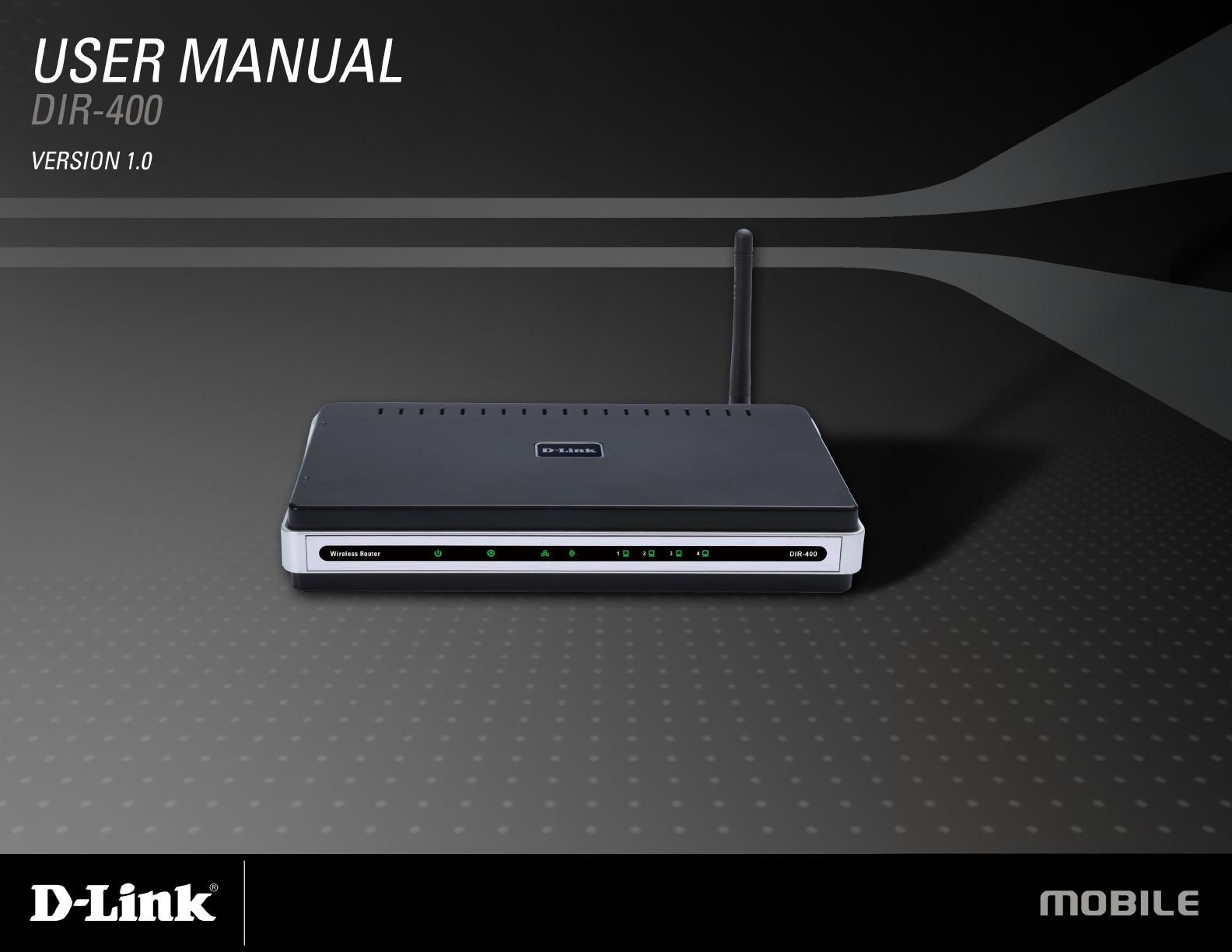

2
D-Link DIR-400 User Manual
Table of Contents
Package Contents ..............................................................4
System Requirements ....................................................4
Introduction ....................................................................5
Features .........................................................................6
Hardware Overview ........................................................7
Connections .............................................................7
Buttons .....................................................................8
LEDs ........................................................................9
Installation .........................................................................10
Before you Begin ..........................................................10
Wireless Installation Considerations ............................ 11
Connecting to a Cable/DSL/Satellite Modem ...............12
Connecting to Another Router ......................................13
Conguration ....................................................................15
Web-based Conguration Utility ...................................15
Setup Wizard .........................................................16
Internet Setup ........................................................22
Dynamic (Cable) ................................................22
PPPoE (DSL) .....................................................23
PPTP ..................................................................24
L2TP...................................................................25
Big Pond ............................................................26
Static (assigned by ISP) .....................................27
Russia PPTP ......................................................28
Russia PPPoE (DSL) .........................................29
Wireless Setup .......................................................30
Enabling WEP Wireless Security ...........................34
Enabling WPA, WPA2, WPA/WPA2 Wireless
Security ..................................................................35
Enabling WPA, WPA2, WPA/WPA2 Wireless Security
for a RADIUS Server ..............................................36
Adding a Wireless Device through WPS ................37
Adding a Wireless Device through WPS (Wi-Fi
Protected Setup) ....................................................38
Adding a Wireless Device through WPS (PIN) ......39
Adding a Wireless Device through WPS (PBC) .....40
LAN Setup ..............................................................41
DHCP Server Settings ...........................................42
DHCP Reservation .................................................43
Time and Date .......................................................44
Parental Control .....................................................45
Port Forwarding .....................................................46
Application Rules ...................................................47
Access Control .......................................................48
Firewall & DMZ - DMZ Host ...................................49
Firewall & DMZ - Firewall Rules .............................50
Advanced Wireless ................................................51
Advanced Network .................................................52
Routing ...................................................................53
Device Administration ............................................54
Save and Restore ..................................................55
Table of Contents

3D-Link DIR-400 User Manual
Table of Contents
Firmware Update ...................................................56
DDNS Settings .......................................................57
System Check ........................................................58
Schedules ..............................................................59
Log Settings ...........................................................60
Log Settings - Email Notication ............................61
Device Information .................................................62
Log .........................................................................63
Statistics .................................................................64
Active Session ......................................................64
Wireless .................................................................65
Help ........................................................................66
Wireless Security ..............................................................67
What is WEP? ..............................................................67
Conguring WEP ..........................................................68
What is WPA? ..............................................................69
Conguring WPA-PSK and WPA2-PSK .......................70
Conguring WPA/WPA2-PSK .......................................71
Conguring WPA, WPA2, & WPA/WPA2 (RADIUS) .....72
Connecting to a Wireless Network .................................73
Using Windows® XP .....................................................73
Congure WEP.............................................................74
Conguring WPA-PSK..................................................76
Setting Up Wi-Fi Protection .............................................78
(WCN 2.0 in Windows Vista) ............................................78
Initial Router Conguration for Wi-Fi Protection ...........78
Setting Up a Congured Router ...................................79
Changing the Computer Name and Joining a
Workgroup ........................................................................80
Conguring the IP Address in Vista ...............................82
Connecting to a Secured Wireless Network (WEP,
WPA-PSK & WPA2-PSK) ..................................................85
Connecting to an Unsecured Wireless Network ............89
Troubleshooting ...............................................................93
Wireless Basics ................................................................97
What is Wireless? ........................................................98
Wireless Setup Tips ...................................................100
Wireless Modes ..........................................................101
Networking Basics .........................................................102
Checking your IP address ..........................................102
Assigning a static IP address .....................................103
Technical Specications ................................................104
Contacting Technical Support .......................................106
Warranty ..........................................................................107
Registration ..................................................................... 112
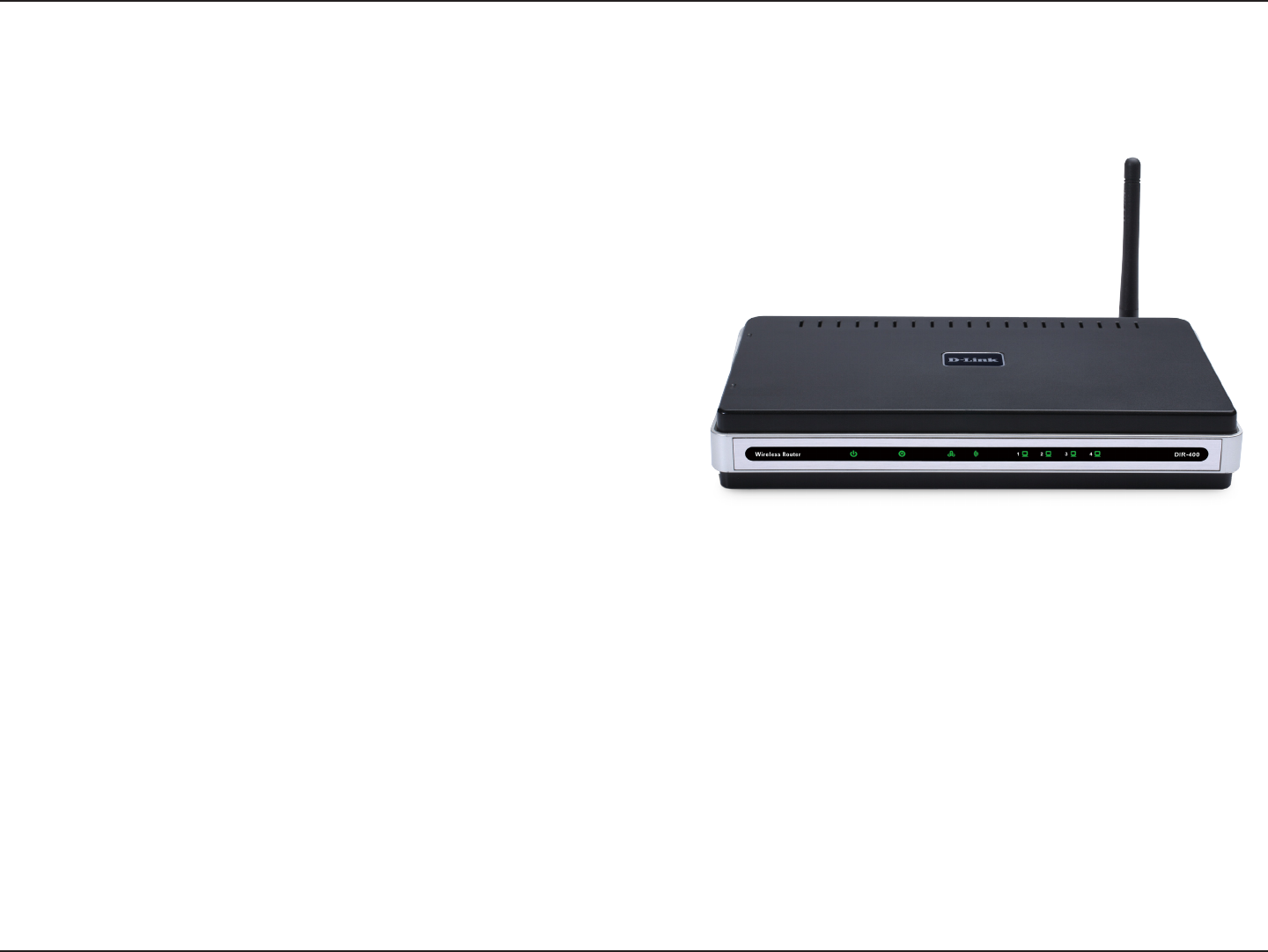
4D-Link DIR-400 User Manual
Section 1 - Product Overview
• D-Link DIR-400 Wireless Router
• Power Adapter
• Ethernet Cable
• Manual and Warranty on CD
System Requirements
• Ethernet-based Cable or DSL Modem
• Computers with Windows®, Macintosh®, or Linux-based operating systems with an installed Ethernet
adapter
• Internet Explorer Version 6.0 or Mozilla Firefox 1.5 above (for conguration)
Package Contents
Note: Using a power supply with a different voltage rating than the one included
with the DIR-400 will cause damage and void the warranty for this product.
Note: Always attach the power cord plug to the power supply, before inserting
the power cord and connected power supply to the wall outlet.

5D-Link DIR-400 User Manual
Section 1 - Product Overview
Introduction
D-Link, the industry leader in wireless networking, introduces another breakthrough in wireless connectivity. The
D-Link DIR-400 Wireless 108 G Router is capable of transferring data with a maximum wireless signal rate of up toDIR-400 Wireless 108 G Router is capable of transferring data with a maximum wireless signal rate of up toWireless 108 G Router is capable of transferring data with a maximum wireless signal rate of up to
108Mbps* through its 108Mbps Turbo mode*, and is also compatible with 802.11b/g. The D-Link DIR-400 Wireless
Router also offers four Ethernet ports to support multiple computers.
The advanced wireless technology built into the DIR-400 Wireless Router offers data transfer speeds with a maximum
wireless signal rate of up to 108Mbps* through its wireless channels, allowing streaming videos and other high bandwidth
applications such as online gaming to operate without the hassle of Ethernet cables. The ability to use high bandwidth
applications also makes streaming real-time programs more enjoyable and more efcient.
With the DIR-400 Wireless Router’s built-in advanced rewall, threats of hackers penetrating your network are minimized.
Some rewall features include functions that allow or disallow certain ports to be open for certain applications. Time
scheduling can be established as a rewall rule so that specic ports will be open at certain times and closed at other
times. Features like content ltering, MAC ltering, URL blocking, and domain blocking are useful tools to prevent other
unwanted intruders from connecting to your network or browsing restricted sites.
The easy-to-use conguration wizard takes only minutes to set up and guides users step-by-step through conguring
the DIR-400. With its versatile features and a user-friendly interface, the DIR-400 Wireless 108 G Router provides an
enhanced networking experience.
* 108Mbps Turbo mode operates only with other D-Link 108 G products. Maximum wireless signal rate derived from IEEE Standard 802.11g specications.Maximum wireless signal rate derived from IEEE Standard 802.11g specications.
Actual data throughput will vary. Network conditions and environmental factors, including volume of network trafc, building materials and construction,
and network overhead, lower actual data throughput rate. Environmental conditions will adversely affect wireless signal range.

6D-Link DIR-400 User Manual
Section 1 - Product Overview
• Faster Wireless Networking - The DIR-400 provides an up to 108Mbps* wireless connection with other
D-Link 108 G devices. This capability allows users to participate in real-time activities online, such as
video streaming, online gaming, and real-time audio. The performance of this 108 G wireless router gives
you the freedom of wireless networking at speeds 2x faster than 802.11g and 10x faster than 802.11b.
• Compatible with 802.11b and 802.11g Devices - The DIR-400 is still fully compatible with the IEEE
802.11g and 802.11b standards, so it can connect with existing 802.11g and 802.11b PCI, USB and
Cardbus adapters.
• Advanced Firewall Features - The Web-based user interface displays a number of advanced network
management features including:
• Content Filtering - Easily applied content ltering based on MAC Address, URL, and/or
Domain Name.
• Filter Scheduling - These lters can be scheduled to be active on certain days or for a
duration of hours or minutes.
• Secure Multiple/Concurrent Sessions - The DIR-400 can pass through VPN sessions. It
supports multiple and concurrent IPSec and PPTP sessions, so users behind the DIR-400
can securely access corporate networks.
• User-friendly Setup Wizard - Through its easy-to-use Web-based user interface, the DIR-400 lets you
control what information is accessible to those on the wireless network, whether from the Internet or from
your company’s server. Congure your router to your specic settings within minutes.
* 108Mbps Turbo mode operates only with other D-Link 108 G products. Maximum wireless signal rate derived from IEEE Standard 802.11g specications.108Mbps Turbo mode operates only with other D-Link 108 G products. Maximum wireless signal rate derived from IEEE Standard 802.11g specications.
Actual data throughput will vary. Network conditions and environmental factors, including volume of network trafc, building materials and construction,
and network overhead, lower actual data throughput rate. Environmental conditions will adversely affect wireless signal range.
Features
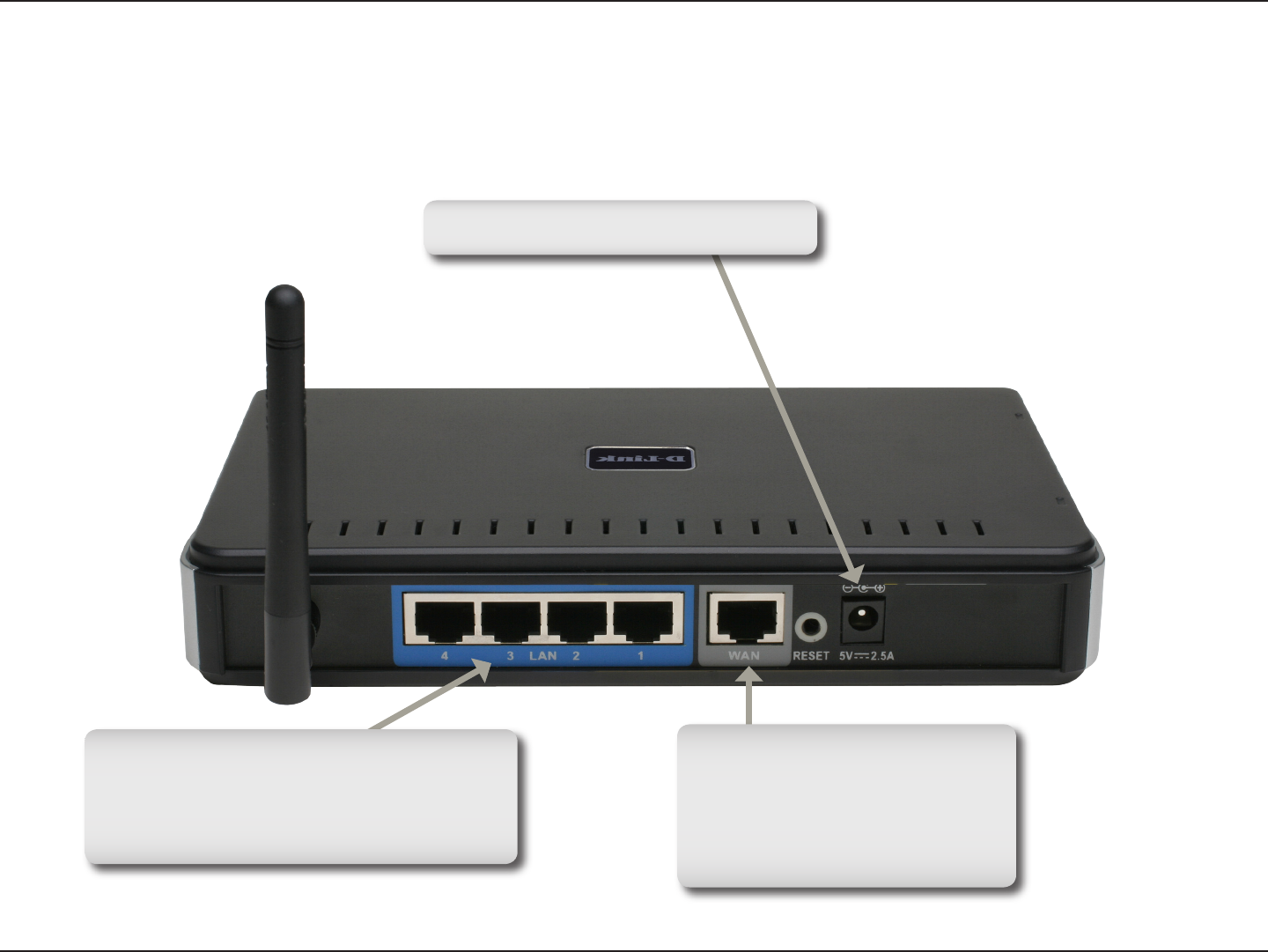
7D-Link DIR-400 User Manual
Section 1 - Product Overview
Hardware Overview
Connections
Connector for the Power Adapter.
The Auto MDI/MDIX WAN
port is the connection for
the Ethernet cable to the
Cable or DSL modem.
LAN Ports
Connects to Ethernet devices such
as computers, switches, and hubs.
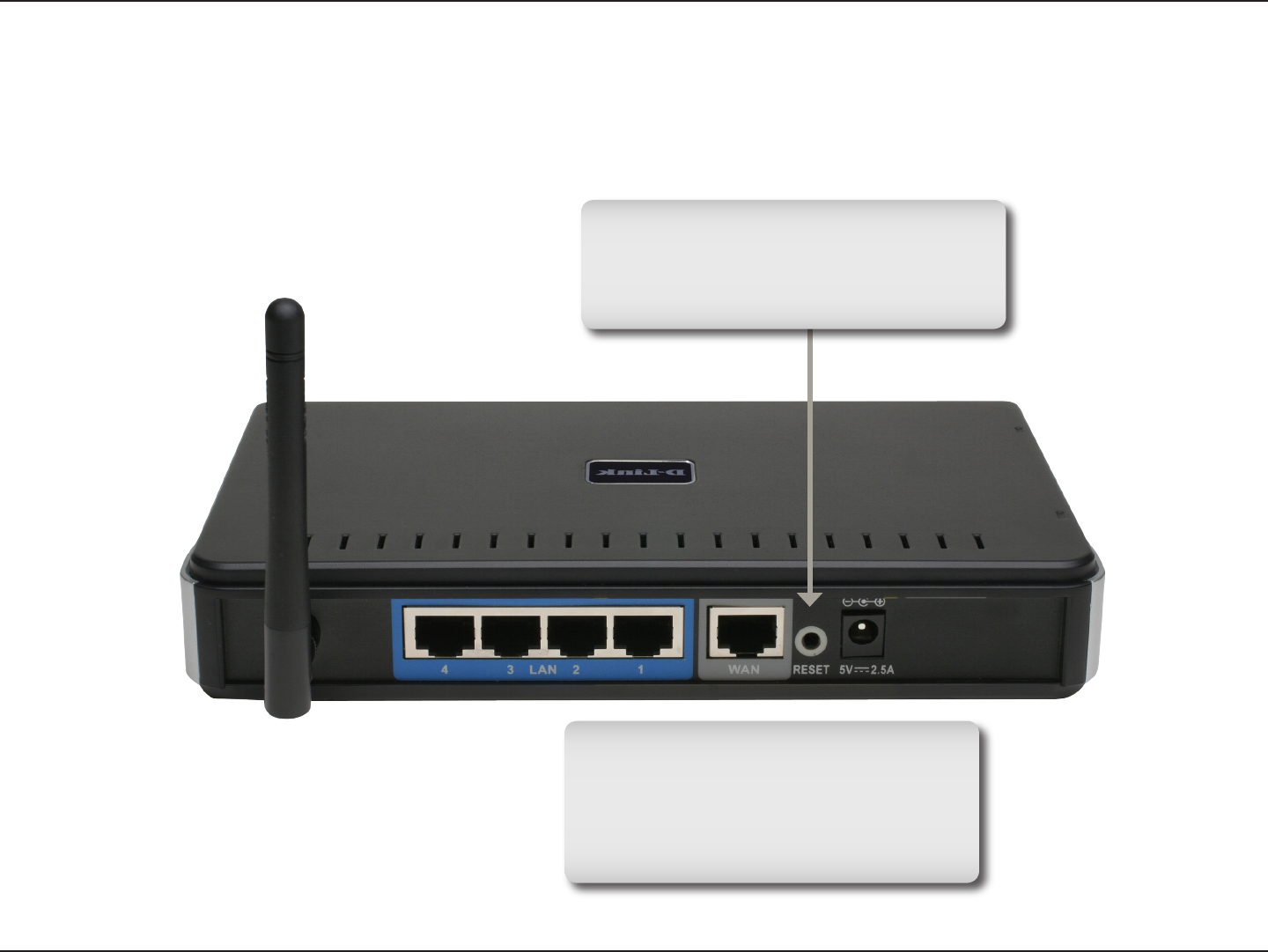
8D-Link DIR-400 User Manual
Section 1 - Product Overview
Hardware Overview
Buttons
The Wi-Fi Protected Setup (WPS)
button is used to connect the router
to other devices that support Push
Button Conguration (PBC).
Pressing the Reset Button restores
the router to its original factory
default settings.
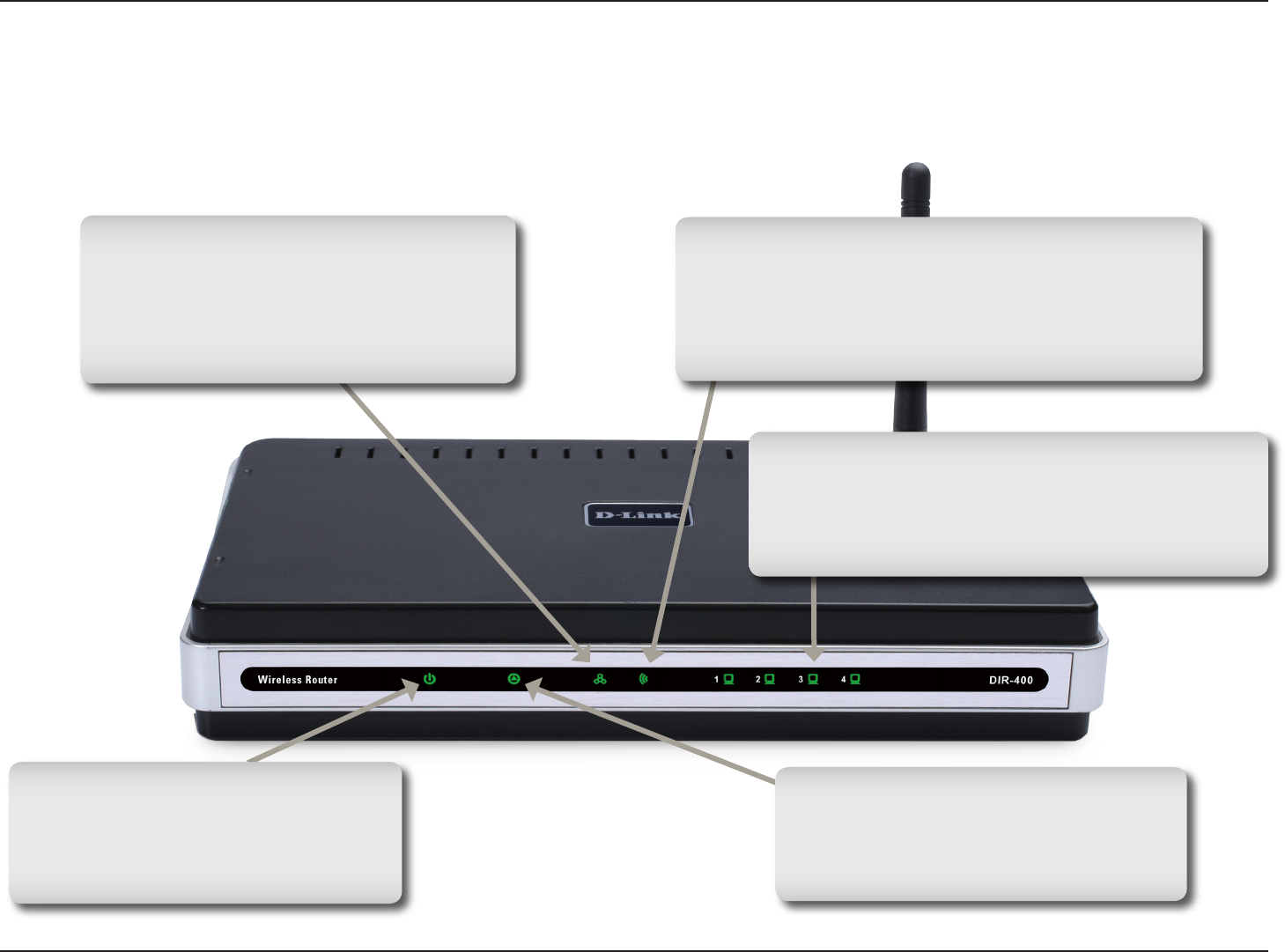
9D-Link DIR-400 User Manual
Section 1 - Product Overview
Hardware Overview
LEDs
WAN LED
A solid light indicates connection
on the WAN port. This LED blinks
during data transmission.
WLAN LED
A solid light indicates that the wireless
segment is ready. This LED blinks during
wireless data transmission.
Local Network LEDs
A solid light indicates a connection to an
Ethernet-enabled computer on ports 1-4.
This LED blinks during data transmission.
Status LED
A blinking light indicates that the
DIR-400 is ready.
Power LED
A solid light indicates a proper
connection to the power supply.

10D-Link DIR-400 User Manual
Section 2 - Installation
Before you Begin
Installation
This section will walk you through the installation process. Placement of the router is very important. Do not place the
router in an enclosed area such as a closet, cabinet, or in the attic or garage.
Please congure the router with the computer that was last connected directly to your modem. Also, you can only
use the Ethernet port on your modem when connecting the modem to the router. If you were using the modem’s USB
connection before using the router, then you must turn off your modem, disconnect the USB cable and connect an
Ethernet cable to the WAN port on the router, and then turn the modem back on. In some cases, you may need to call
your ISP to change connection types (USB to Ethernet).
If you have DSL and are connecting via PPPoE, make sure you disable or uninstall any PPPoE software such as
WinPoet, Broadjump, or Ethernet 300 from your computer or you will not be able to connect to the Internet.

11D-Link DIR-400 User Manual
Section 2 - Installation
Wireless Installation Considerations
The D-Link wireless router lets you access your network using a wireless connection from virtually anywhere within
the operating range of your wireless network. Keep in mind, however, that the number, thickness and location of walls,
ceilings, or other objects that the wireless signals must pass through may limit the range. Typical ranges vary depending
on the types of materials and background RF (radio frequency) noise in your home or business. The key to maximizing
wireless range is to follow these basic guidelines:
1. Keep the number of walls and ceilings between the D-Link router and other network devices to a
minimum - each wall or ceiling can reduce your adapter’s range from 3-90 feet (1-30 meters.) Position
your devices so that the number of walls or ceilings is minimized.
2. Be aware of the direct line between network devices. A wall that is 1.5 feet thick (.5 meters), at a
45-degree angle appears to be almost 3 feet (1 meter) thick. At a 2-degree angle it looks over 42 feet
(14 meters) thick! Position devices so that the signal will travel straight through a wall or ceiling (instead
of at an angle) for better reception.
3. Building materials make a difference. A solid metal door or aluminum studs may have a negative
effect on range. Try to position access points, wireless routers, and computers so that the signal passes
through drywall or open doorways. Materials and objects such as glass, steel, metal, walls with insulation,
water (sh tanks), mirrors, le cabinets, brick, and concrete will degrade your wireless signal.
4. Keep your product away (at least 3-6 feet or 1-2 meters) from electrical devices or appliances
that generate RF noise.
5. If you are using 2.4GHz cordless phones or X-10 devices (wireless products that control devices
such as ceiling fans, lights, and home security systems), your wireless connection may degrade
dramatically or drop completely. Make sure your 2.4GHz phone base is as far away from your wireless
devices as possible. The base transmits a signal even if the phone in not in use.

12D-Link DIR-400 User Manual
Section 2 - Installation
If you are connecting the router to a cable/DSL/satellite modem, please follow the steps below:
1. Place the router in an open and central location. Do not plug the power adapter into the router.
2. Turn the power off on your modem. If there is no on/off switch, then unplug the modem’s power adapter. Shut down
your computer.
3. Unplug the Ethernet cable (that connects your computer to your modem) from your computer and place it into the
WAN port on the router.
4. Plug the included Ethernet cable into one of the four LAN ports on the router. Plug the other end into the Ethernet
port on your computer.
5. Turn on or plug in your modem. Wait for the modem to boot (about 30 seconds).
6. Plug the power adapter to the router and then plug it into an outlet or power strip. Wait about 30 seconds for the
router to boot.
7. Turn on your computer.
8. Verify the link lights on the router. The power light, WAN light, and the LAN light (the port that your computer is
plugged into) should be lit. If not, make sure your computer, modem, and router are powered on and verify that the
cable connections are correct.
9. Skip to page 15 to congure your router.
Connecting to a Cable/DSL/Satellite Modem

13D-Link DIR-400 User Manual
Section 2 - Installation
If you are connecting the D-Link router to another router for use as a wireless access point and/or switch, you will have
to do the following before connecting the router to your network:
• Disable UPnP™
• Disable DHCP
• Change the LAN IP address to an available address on your network. The LAN ports on the router cannot
accept a DHCP address from your other router.
To connect to another router, please follow the steps below:
1. Plug the power adapter into the router. Connect one of your computers to the router (LAN port) using an Ethernet
cable. Make sure your IP address on the computer is 192.168.0.xxx (where xxx is between 2 and 254). Please
see the Networking Basics section for more information. If you need to change the settings, write down your
existing settings before making any changes. In most cases, your computer should be set to receive an IP address
automatically in which case you will not have to do anything to your computer.
2. Open a web browser and enter http://192.168.0.1 and press Enter. When the login window appears, set the user
name to admin and leave the password box empty. Click OK to continue.
3. Click on Advanced and then click Advanced Network. Uncheck the Enable UPnP checkbox. Click Save Settings
to continue.
4. Click Setup and then click Network Settings. Uncheck the Enable DHCP Server checkbox. Click Save Settings
to continue.
5. Under Router Settings, enter an available IP address and the subnet mask of your network. Click Save Settings to
save your settings. Use this new IP address to access the conguration utility of the router in the future. Close the
browser and change your computer’s IP settings back to the original values as in Step 1.
Connecting to Another Router

14D-Link DIR-400 User Manual
Section 2 - Installation
6. Disconnect the Ethernet cable from the router and reconnect your computer to your network.
7. Connect an Ethernet cable to one of the LAN ports of the router and connect it to your other router. Do not plug
anything into the WAN port of the D-Link router.
8. You may now use the other three LAN ports to connect other Ethernet devices and computers. To congure your
wireless network, open a web browser and enter the IP address you assigned to the router. Refer to the Conguration
and Wireless Security sections for more information on setting up your wireless network.
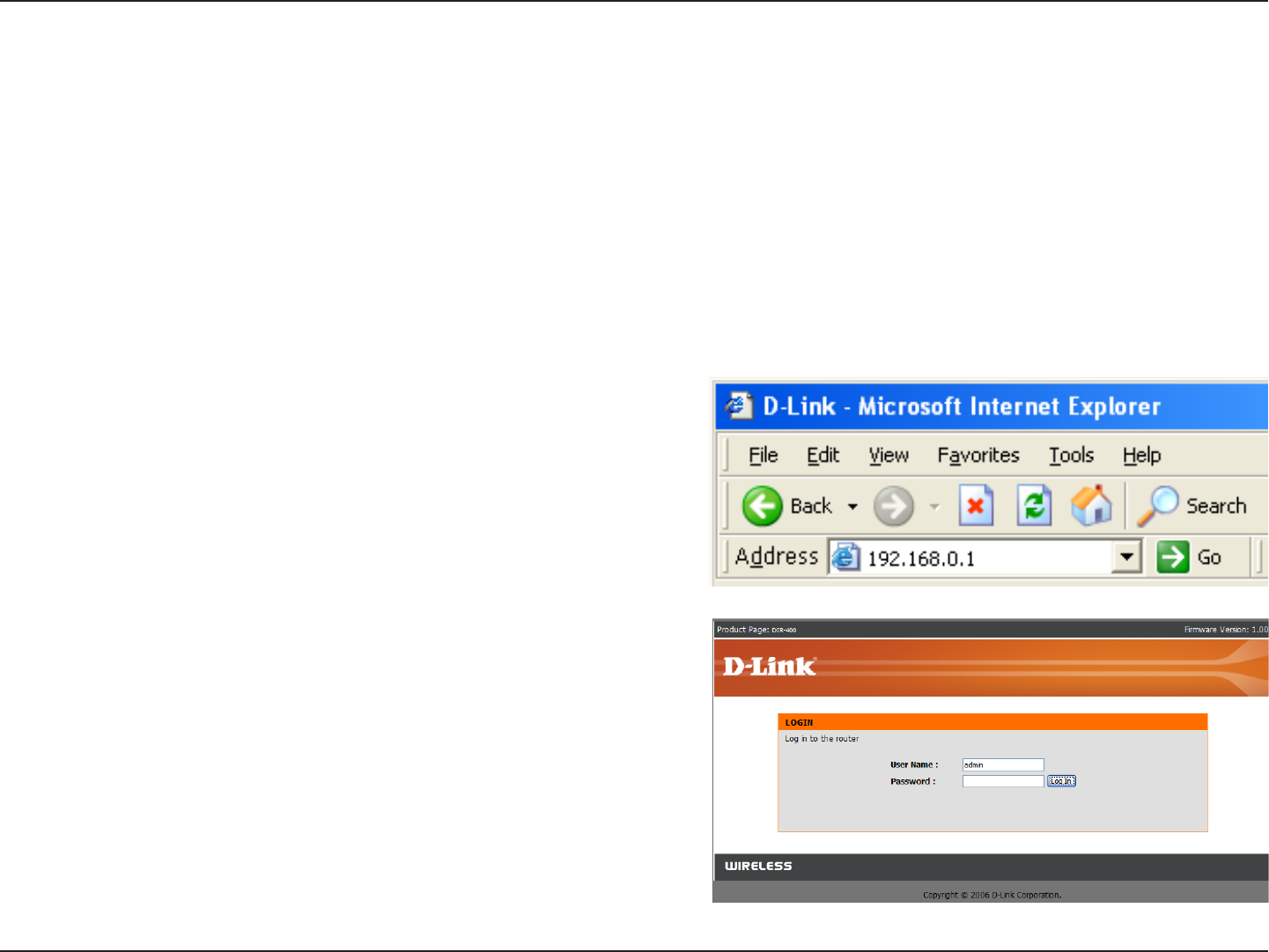
15D-Link DIR-400 User Manual
Section 3 - Conguration
Configuration
This section will show you how to congure your new D-Link wireless router using the web-based conguration
utility.
Web-based Configuration Utility
To access the conguration utility, open a web-browser
such as Internet Explorer and enter the IP address of
the router (192.168.0.1).
Enter the user name (admin) and your password. Leave
the password blank by default.
If you get a Page Cannot be Displayed error, please
refer to the Troubleshooting section for assistance.